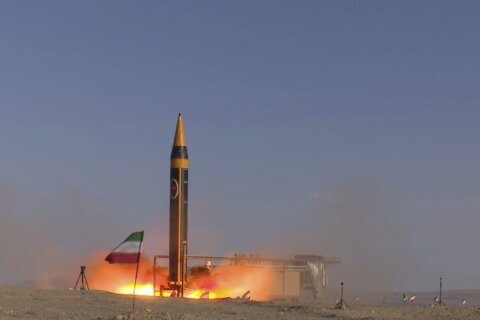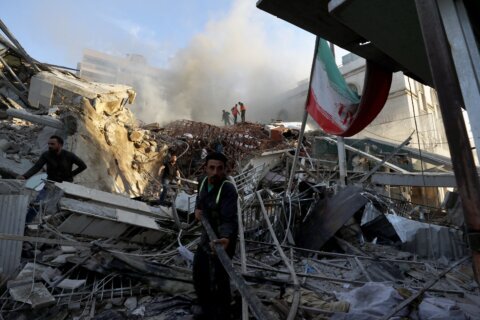WASHINGTON – Al-Qaida has been rebuilding itself, little by little, despite the withering drone attacks that have killed key figures including Osama bin Laden and Anwar al-Awlaki. But much of that rebuilding may be going on outside the view of the U.S. intelligence community.
A former U.S. intelligence official tells WTOP “there’s been a shift in the last few years in the way the U.S. pursues terrorists. The U.S. is more reluctant to capture and detain terrorists.”
While not going into great detail, the former official says “risk, humanitarian and political concerns that grew out of Guantanamo Bay detention debate are all key considerations.”
Although the U.S. government and military don’t routinely discuss their pursuit of suspected terrorists, physical evidence in Pakistan and Yemen indicates that while detention is not the preferred method of dealing with terrorists, drone strikes are.
The U.S. has killed an estimated 2,740 militants in Pakistan and 750 in Yemen since 2004, according to New America Foundation and WTOP calculations. Those figures included a significant increase in strikes and killings in recent years.
But the success has a down side. Current and former U.S. intelligence officials say actionable intelligence from a living being is preferable to the dead end that a drone often results in.
Jose Rodriguez, former Director of the Central Intelligence Agency’s National Clandestine Service says “the enhanced interrogation program, among others were keys that allowed us to defend the homeland and destroy al-Qaida and eventually led to the killing of bin Laden.”
It’s his contention that the U.S. was able to slowly build first-person intelligence by capturing al-Qaida operatives. He says counterterrorism authorities were able to dialogue with terrorism suspects and build relationships.
Through such programs, the U.S. intelligence community learned “a lot about the organization, the leadership, their logistics, their finances, their programs and also gave us the blueprint that allowed us to go out and start capturing senior al-Qaida leaders,” says Rodriguez.
It was a slow, but productive route.
“Prior to 9/11 and in the months following 9/11 we did not have a good understanding of what was going on in al-Qaida. We did not know about their leadership or their weapons programs — biological or nuclear,” says Rodriguez.
“Building a strong base of actionable intelligence against Al Qaida was a 10-year process and at the end of the 10-year process, we had decimated the leadership and bin Laden had been killed,” he adds.
And as the U.S. scrambles to collect, analyze and disseminate intelligence about the current plot, some U.S. intelligence observers are reminded that the volumes of intelligence that was developed and acted upon after 9/11 may be approaching the end of their usefulness, while new intelligence may be harder to come by.
Juan Zarate, senior adviser at the Center for Strategic and International Studies says, “We’re in the post-bin Laden era, well after 9/11 and the question here is, what our security and threat environment looks like and how shall we be thinking about defending in a period of multiple threats?”
Those threats no longer come from the traditional places and ideologies that led to the rise of pre-9/11 al-Qaida.
A U.S. counterterrorism official tells WTOP, “Terrorist threats are evolving as the global jihadist movement becomes increasingly decentralized. In North Africa, the extremist landscape is a mosaic of experienced groups, rebranded militants, terrorists emerging from the shadows, and new entries. There’s plenty of rivalry in the small world of militant Jihadists but also some limited transnational cooperation that is cause for concern.”
And the variety of threats may call for the deployment of a variety of tools to cope with them. In addition to the CIA, NSA and its international partners, the U.S. military is playing a larger role in combating the terror threat.
“We’ve increased our response options in the region over the past year since Benghazi and are watching the situations very closely as we work to support the State Department,” says Colonel W. Thomas Jr., spokesman for Chairman of the Joint Chiefs of Staff, Martin Dempsey.
The State Department announcement that almost two dozen embassies, mostly in North Africa and the Middle East, would close on Aug. 4 signaled something big was in the works. U.S. officials said intercepted messages and other intelligence presented a credible, but unspecified threat from al-Qaida in the Arabian Peninsula (AQAP). The extension of the closures through the end of this week have fueled concerns that the threat may be bigger than embassy security forces are prepared for and has raised questions about how the State Department’s Diplomatic Security Service will handle security.
Fred Burton, former State Department Diplomatic Security official, says they have a specific approach to protect the embassies in question.
“The first thing they will try to do is minimize the numbers of personnel on staff that day. You decrease the presence of official Americans and get down to a core team of regional security officers — the Marine security guards and you have everybody else stay home,” he says.
The threat extends well beyond the Middle East and North Africa and has prompted global organizations to take action.
Interpol issued a global security alert advising increased vigilance for terrorist activity. The international law enforcement agency said suspected al-Qaida involvement in several of the nine recent breakouts drove their decision to issue the alert. Hundreds of terrorists including al-Qaida operatives and other criminals were among those that escaped.
Also, Interpol says “August is the anniversary of violent terrorist incidents in Mumbai, India and Gluboky, Russia as well as in Jakarta, Indonesia. This week also marks the 15th anniversary of the U.S. Embassy bombings in Nairobi, Kenya and Dar es Salaam, Tanzania in which more than 200 mostly African citizens were killed and 4,000 others injured.”
In recent years, terrorist attacks focusing on diplomatic facilities in Afghanistan, Greece, India, Kenya, Libya, Pakistan, Peru, Saudi Arabia, Syria, Tanzania, Turkey and Yemen have also resulted in hundreds of casualties of all nationalities.
When the U.S. diplomatic facilities do reopen, they still be faced with the ongoing threat AQAP presents. The U.S. counterterrorism official says “in the Near East there’s no doubt that during the last few years AQAP has remained focused on external plotting even as it has fought a ground war against the Yemeni government. It’s a capable and still dangerous AQ-affiliate.”
Follow @WTOP on Twitter.







